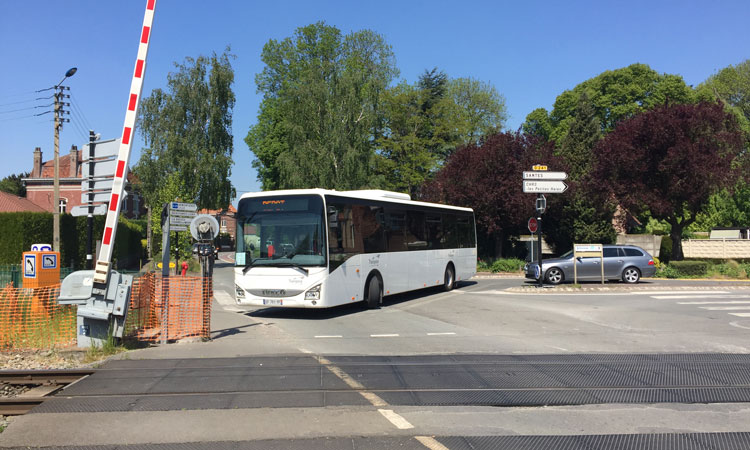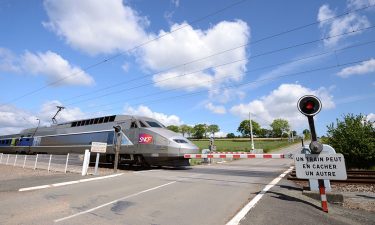Cross-sector collaboration to improve level crossing safety in France
Posted: 2 July 2020 | Alain Autruffe | No comments yet
Alain Autruffe, Level Crossing Programme Director at SNCF Réseau, writes about the importance for both the road transport industry and the railway industry in France to work together in educating the public about the dangers at level crossings.


Approximately 100 collisions between a vehicle or pedestrian and a train occur each year across the rail network in France, resulting in between 20 and 40 deaths.
A level crossing is no ordinary junction; these junctions are not only the responsibility of SNCF Réseau (in charge of managing the functioning of the crossing and its signage), but also the road authorities (local council, department or the State) who maintain the approach, the warning signs and, with police assistance, ensure that the Highway Code is adhered to. The road layout should ensure the utmost safety on the crossing and should be competently planned and built by the relevant highway authority.
The most common level crossings are those equipped with Automatic Light Signalling (ALS), audible warnings and traffic lights. There are approximately 10,500 in France, at which 450,000 closure cycles occur every day and 16 million daily vehicle crossings.
Accident statistics
Approximately 100 collisions between a vehicle or pedestrian and a train occur each year across the rail network in France, resulting in between 20 and 40 deaths. The number of accidents at level crossings evolves in the same way as the number of ordinary road accidents in France. The train driver and the train passengers are equally at risk when a train collides with a road vehicle, with great possibility of derailing the train. Truck and bus drivers should be the first to understand the risks involved in using level crossings and know how best to deal with the situation when an emergency arises.
Level crossing safety study


There are approximately 10,500 ALS crossings in France at which 450,000 closure cycles occur every day
Following the tragic accident in December 2017 at Millas in southern France, when six children on a school bus lost their lives when a train collided with it, the French government commissioned a study by the French MP Laurence Gayte into safety at level crossings. After six months of intensive research and numerous interviews with authorities, experts and victims’ associations, Laurence published her report in April 2019. The central theme of her 12 recommendations was the interaction between the railway authorities, the road authorities and those responsible for road safety. A level crossing is not just a section on a railway but, first and foremost, a road feature.
Did you know…
SNCF Réseau spends €120 million each year on level crossing maintenance. More than €51.8 million was invested in 2018 for removing level crossings, and more than €20 million was invested in improving level crossing safety. SNCF also spends €1.5 million every year on implementing public awareness about level crossing safety.
Action taken
In accordance with the recommendations outlined in the parliamentary report, SNCF Réseau concluded an agreement with the following three road transport federations:
- Fédération Nationale de Transport Voyageurs (FNTV): A national coach federation representing two-thirds of the French bus and coach companies, incorporating 1,000 companies with 45,000 buses on the roads
- Union des Transports Publics (UTP): A public transport union representing 170 urban bus companies (urban bus routes include travelling over 150 level crossings)
- Fédération Nationale des Transports Routiers (FNTR): A national road transport federation representing two-thirds of the French road haulage companies.
An analysis of the events before the accident at Millas showed a great lack of understanding about the way level crossings work by professional drivers, in the following three specific areas:
- An overestimation of the time between the beginning of the warnings and the arrival of a train. In France, the minimum gap between a half-barrier closing and the train arriving is 25 seconds. In unexpected circumstances, time passes very quickly.
- The fact that the barriers are breakable and a driver in difficulty should just drive through them if a train is coming.
- The unawareness that the crossing telephone is linked directly with the nearest station, and the trains can be halted very quickly in an emergency. In 2015, a very serious accident occurred between a HGV stalled on a level crossing and a train; during the six minutes it took for the train to arrive, the lorry driver didn’t think to use the level crossing phone.
These agreements are based on the following two guiding principles:
- Make bus and lorry drivers and SNCF Réseau aware of the perceived risks of drivers, share information regarding incidents and work together to improve security. In return for a rapid notification of a risk, SNCF Réseau agrees not to file complaints.
- SNCF Réseau is committed to making transport company associations aware of specific risks at level crossings and of the rules to be obeyed, pointing them out at transport companies’ regional annual general meetings, based on documents provided by the International Union of Railways (UIC).
Furthermore, road transport associations and SNCF Réseau also wish to put pressure on the GPS cartography publishers to show level crossings on maps, with professional versions including vital details, such as width and height limits, as well as low-loader tolerances. The GPS coordinates of level crossings have been made available in open data on the SNCF Réseau website.
Otherwise, SNCF Réseau has forged a link with a transport training association which trains and provides continual development for professional drivers – the Association de Formation des Transports (AFT). Six different level crossing use scenarios have been drawn up in virtual reality. Each trainee can, in a virtual reality environment, cross a level crossing, make decisions and learn their consequences. SNCF Réseau and AFT estimate that this type of innovative training will allow for better understanding, memorisation and use of level crossings. In this way, it is estimated that, each year, 8,000 drivers will be able to make significant progress in becoming aware of the risks and, in addressing them, respect the Highway Code rules of level crossings. An attractive presentation of this training is available on the AFT website.
Conclusion
These actions are an act of cooperation and trust between the road transport industry and the railway industry, concerning the risks of the interaction between the two infrastructures, which are very differently planned and used. It goes without saying that it will require much effort and perseverance on the part of both industries to work together.










